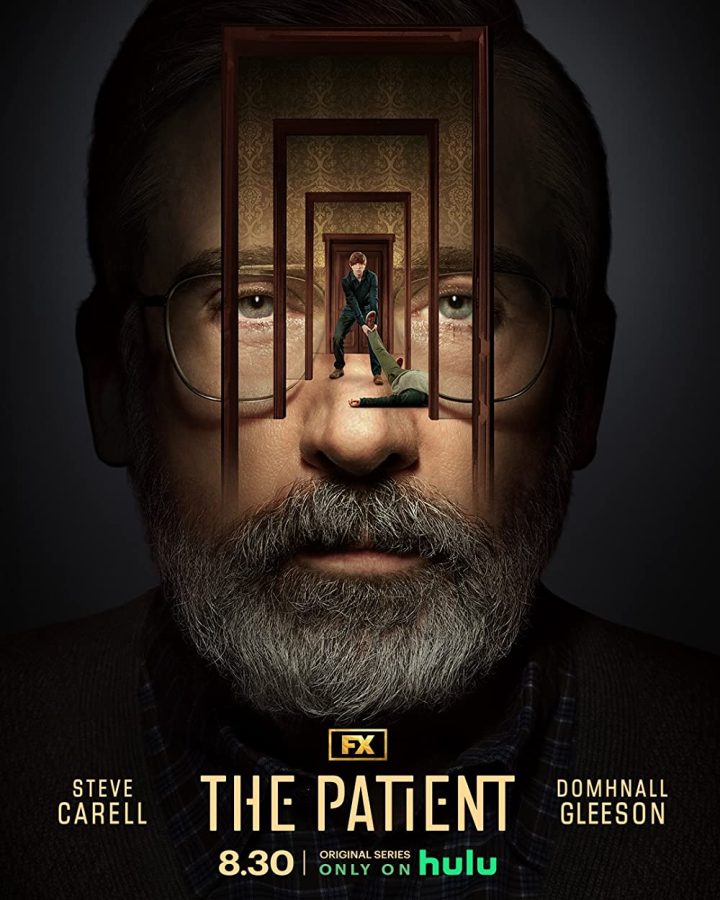The Patient left me physically drained, yet completely satisfied in every respect
I love the Harry Potter franchise with my whole heart, so when I saw Bill Weasley’s (Domhnall Gleeson) face on the cover of a new Hulu psychological thriller, I had to watch it.
The Patient, starring Steve Carell and the aforementioned Domhnall Gleeson, was released in August of 2022. The ten total episodes aired weekly until the finale in October.
It starts out with psychiatrist Alan Strauss (Carell) being kidnapped by his new patient, Sam Fortner (Gleeson). His reason is expressed as soon as an opportunity is given: Sam is a serial killer. The only way Sam believed he could stop was by chaining his therapist up in his basement in order to provide around-the-clock counseling.
To keep himself from insanity, Alan uses his own idiosyncrasies to maintain his mindset, all while trying to stop a serial killer’s homicidal tendencies. The problem is that it’s not always an emotional want for Sam to kill anymore; he just doesn’t know how to stop.
Sam does his best to make Alan semi-comfortable, providing his medications, glasses, foot cream, and even his favorite toothpaste for him. It’s a conflicting thing for Alan, Sam, and the viewer alike because it’s almost pitiful at times.
We learn that Alan had left family matters on a particularly low note. He had fought with his son, Ezra (Andrew Leeds), regarding the differences in their faith systems, and Alan’s wife, Beth (Laura Niemi), had died of cancer not long before his kidnapping.
So, how else to cope, but to indulge in therapy of his own?
Perhaps one of the most fascinating facets of this show was the presence of Alan’s own past—and deceased—therapist, Charlie, played by David Alan Grier.
There are daydreams, of sorts, that we see taking place in Alan’s mind, involving sessions with Charlie. It became a coping mechanism of sorts for him, allowing him to reflect and analyze the happenings of his captivity through his own mind. It also allows him to detach himself from it and look at the situation through the eyes of a different professional.
In the third episode, the viewer is introduced to another major character: Sam’s mother, Candace, played by Linda Emond.
This show, in particular, has made me more conflicted than possibly any work of crime-related fiction I’ve watched.
Admittedly, this is a hugely important piece to the story, considering the fact that Candace had known of her son’s habits the whole time. Without sharing too much information, she didn’t indulge in these, but she didn’t really try to stop them.
Anybody who knows me knows that there are very few moments, especially while watching TV, in which I don’t feel bad for someone. This show, in particular, has made me more conflicted than possibly any work of crime-related fiction I’ve watched. I’m heartbroken for Alan and Ezra, but also for Sam and Candace.
The finale was one that I analyzed in my head for literally days after finishing it, and, though I wish more than anything that I could elaborate more on it, I can’t risk spoiling the ending.
In terms of the acting, every actor on the roster was phenomenal in that it was one of the most delicately elusive dramas I’ve ever seen.
Steve Carell is iconic as a comedian, but his roles in dramatic films and shows have never failed to leave me blown away. He may be known as Michael Scott to many, but I believe nobody could top his performances in this series and the film Beautiful Boy.
Domhnall Gleeson, though my primary recollection of his works includes Harry Potter, About Time, and dramas such as Brooklyn, I was absolutely astounded by his performance as the titular character in The Patient.
Andrew Leeds, though I’d told myself I wouldn’t like his character simply because he played a villain on Bones, was one of the most gut-wrenching things to watch in this show for me. We see all of his internal conflict so masterfully mustered into nearly a physical stain on his face.
Even if it is a psychological thriller—and likely not for the faint of heart—The Patient completed exactly what it was intended to. The show itself acted as a therapist, forcing the watcher—or the patient, I suppose—to conclude things on their own. It doesn’t spoon-feed us the answers, but it lays the pieces in front of us to analyze individually.

Eva LaBeau is a senior entering her second year on The Central Trend. She takes on everything she does with great passion, specifically when relating to...































































































